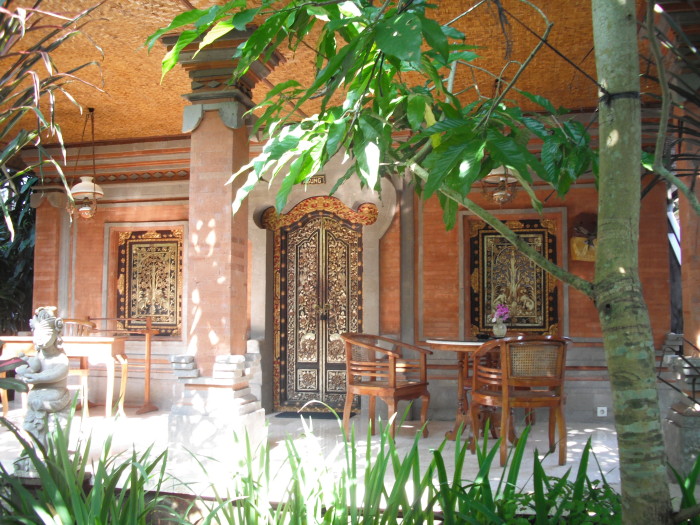Bali Hotel Architecture
We stayed in two hotels in Bali: One was a 3-month old penthouse suite overlooking the ocean (in Bali, even we can afford such a thing), and the other was a bungalow in the small city of Ubud, adjacent to the Saraswati Temple there. Both advertised themselves as bungalows, although they were adjoined to one or two other units; I guess the idea is that the bungalow is not so much an independent unit as a small duplex or triplex, differentiated from a regular giant impersonal hotel. At any rate, both places had big verandas, carved wooden doors, and traditionally built roofs/ceilings. Here’s the ceiling.
 It’s made of teak (I think) beams overlaid with matting made of coconut leaves, with a tile roof above that. You can stay in thatched bungalows as well, in which case the ceiling is a view of rows and rows of neatly-tied thatch, knotted to lateral bamboo beams. Either one is pleasingly symmetrical to look at, waterproof (if your thatch is updated) and quiet in a rainstorm.
It’s made of teak (I think) beams overlaid with matting made of coconut leaves, with a tile roof above that. You can stay in thatched bungalows as well, in which case the ceiling is a view of rows and rows of neatly-tied thatch, knotted to lateral bamboo beams. Either one is pleasingly symmetrical to look at, waterproof (if your thatch is updated) and quiet in a rainstorm.
The veranda by the sea came with huge views and enormous wooden couches, suitable for two people to sleep on:
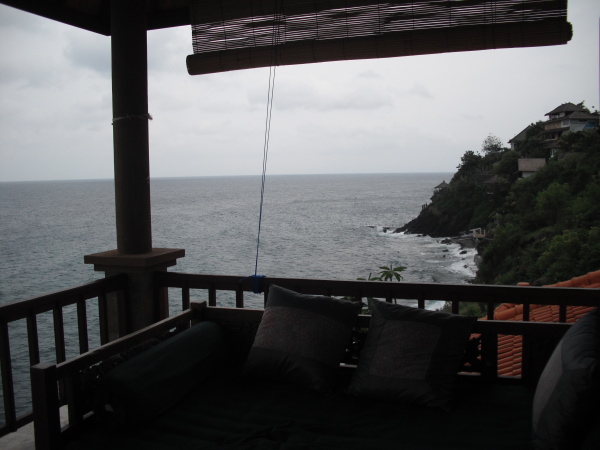 I know this is a dark picture, but you can make out the couch. We spent a LOT of time on these couches, reading, drinking coffee, watching the weather and fishing boats, and just hanging out.
I know this is a dark picture, but you can make out the couch. We spent a LOT of time on these couches, reading, drinking coffee, watching the weather and fishing boats, and just hanging out.
Here’s the carved wooden door from the beach unit:
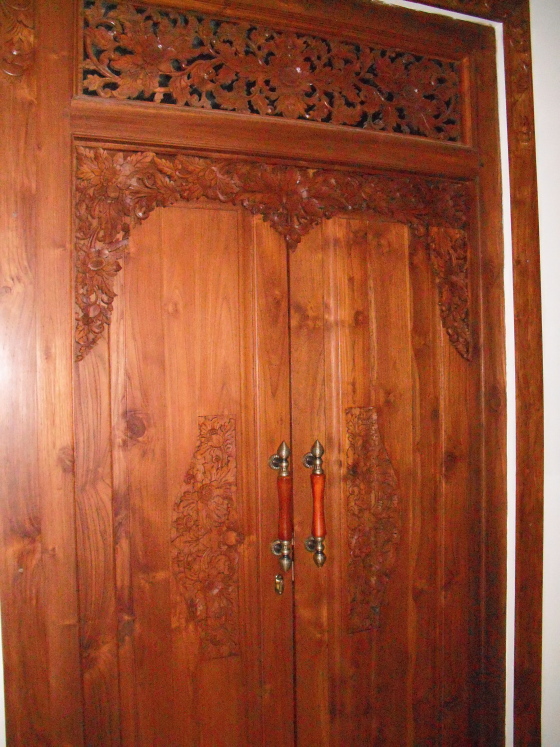 Like many doors in Bali it’s split. The two halves open inward, and the carving at their tops is actually just a detached stationary frame. It had a modern key lock on the inside, while older buildings have a chunk of wood that you slide through slots on the two door halves to keep them together. For comparison, below is the veranda and carved wooden door (and window cover) from our temple bungalow in Ubud:
Like many doors in Bali it’s split. The two halves open inward, and the carving at their tops is actually just a detached stationary frame. It had a modern key lock on the inside, while older buildings have a chunk of wood that you slide through slots on the two door halves to keep them together. For comparison, below is the veranda and carved wooden door (and window cover) from our temple bungalow in Ubud:
The beach hotel boasted three infinity pools, so maybe a total of ten users per pool. Here’s the one we had access to:
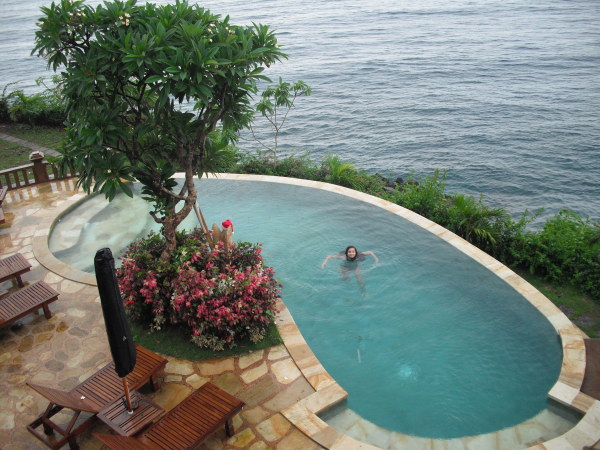 And the beach bungalows feature outside showers adjacent to the bathrooms, a pretty common phenomenon in Bali, and very practical. If you don’t close the bathroom door you get tiny many-footed visitors. But look at the hand-laid stonework:
And the beach bungalows feature outside showers adjacent to the bathrooms, a pretty common phenomenon in Bali, and very practical. If you don’t close the bathroom door you get tiny many-footed visitors. But look at the hand-laid stonework:
Which brings me to the topic of stone carving. You’ve seen the beautiful wood carving on the doors and windows. But the Balinese can do that stuff in stone, too, and they do it EVERYWHERE. Here’s half of the gate to an abandoned bungalow complex overlooking the sea:
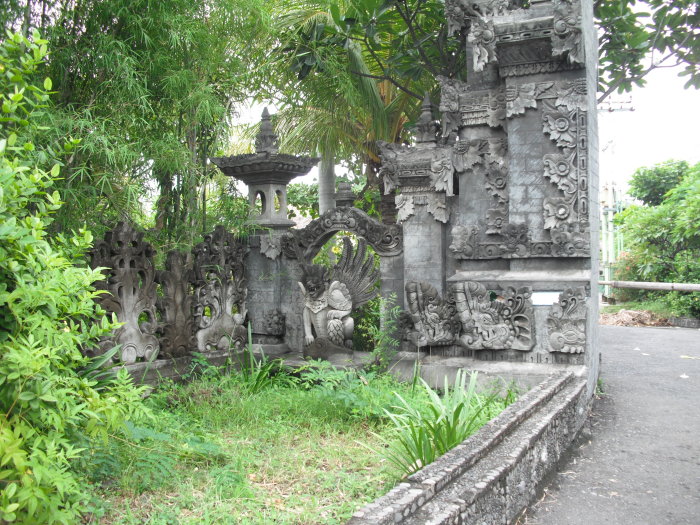 There’s another gate like this on the right-hand side of the road, symmetrical in every way. Splayed-winged Garuda, curious elephantine heads, flourishes, curlicues, flowers, you name it. I originally thought this was a temple or a graveyard, since there’s an elaborately carved stone fence all around the complex; but Komang John, who runs the Blue Moon Villas where we stayed, said he’d heard that it was another bungalow-based resort that had been sold a few years ago, and the owners were awaiting planning permission before rennovating.
There’s another gate like this on the right-hand side of the road, symmetrical in every way. Splayed-winged Garuda, curious elephantine heads, flourishes, curlicues, flowers, you name it. I originally thought this was a temple or a graveyard, since there’s an elaborately carved stone fence all around the complex; but Komang John, who runs the Blue Moon Villas where we stayed, said he’d heard that it was another bungalow-based resort that had been sold a few years ago, and the owners were awaiting planning permission before rennovating.
Once we were in Ubud, we were walking around the city and needed lunch. I saw a menu posted on the sidewalk, advertising food and lodgings at the cottages just down the alley, so we followed the alley (always a good idea in Ubud), and found bungalows, with a restaurant and pool. Look at what someone had carved in the small cliff between the restaurant pool and the street above:
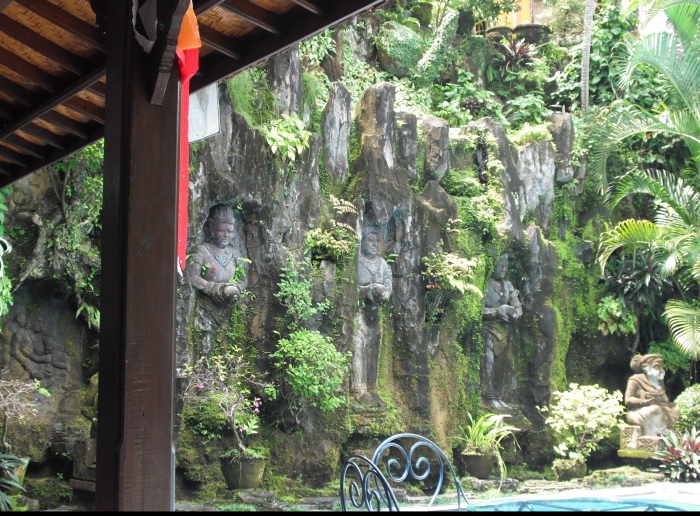 This is the view from the restaurant, over the pool to the cliff. The water nymphs are conveniently close to the pool. As our offspring noted, it was kind of like those Buddhas in niches that the Taliban blew up in Afghanistan some years ago, on a smaller scale.
This is the view from the restaurant, over the pool to the cliff. The water nymphs are conveniently close to the pool. As our offspring noted, it was kind of like those Buddhas in niches that the Taliban blew up in Afghanistan some years ago, on a smaller scale.
But the carving mania is not limited to floral motifs and gods. As we left this restaurant, this statue saw us off:
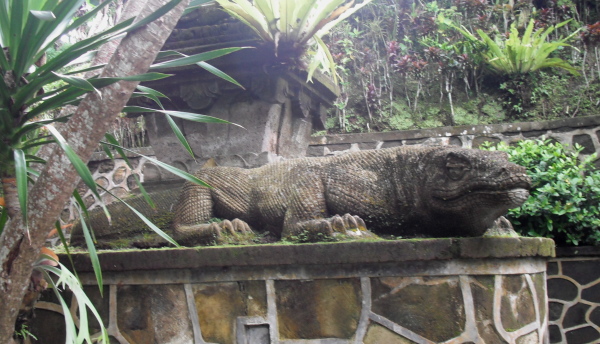 Nothing like an enormous water monitor posted at a gateway to wish you a safe journey!
Nothing like an enormous water monitor posted at a gateway to wish you a safe journey!
